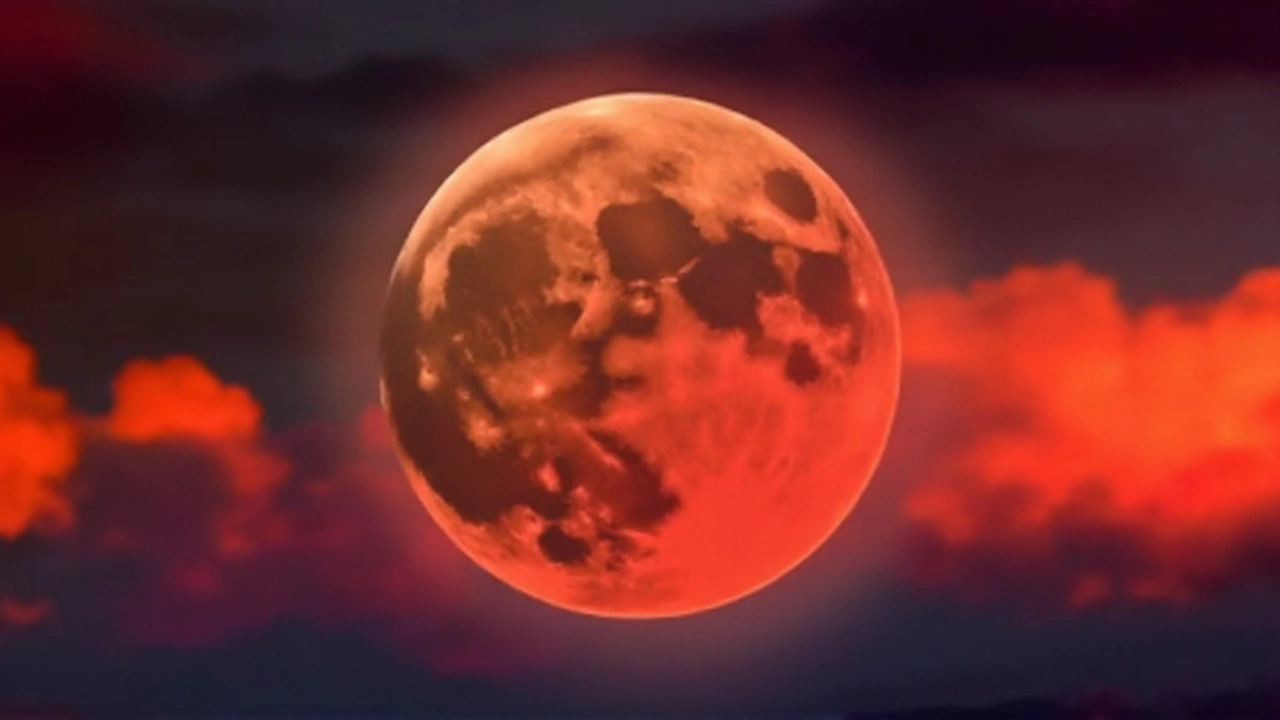
What’s happening and who gets the best view
A deep, coppery “blood moon” is on the way. On the night of September 7–8, 2025, a total lunar eclipse will sweep across the Eastern Hemisphere, marking the second and final total lunar eclipse of 2025. Totality runs an unusually long 82 minutes—from 17:30 to 18:52 GMT—making it the longest since 2022. End to end, the eclipse lasts a bit over five hours.
Lunar eclipses are simple at heart: Earth moves between the Sun and the full Moon, and our planet’s shadow washes across the lunar surface. The Moon turns red because sunlight bending through Earth’s air filters out blue light, a process called Rayleigh scattering—the same physics behind red sunsets. How bright or dark the Moon looks depends on what’s in our atmosphere that night. Clean, clear air can yield a bright brick-red disk; dust or volcanic haze can push it toward rust or even brown. Astronomers often describe this with the Danjon scale (L=0 to L=4), but the exact color is never certain until the moment.
This eclipse is widely visible. About 77% of people on Earth will have at least some view, with the best seats across Asia and Western Australia, where the entire event unfolds in the middle of the night. In Perth, totality runs from 1:30 to 2:52 a.m. local time (Sept. 8). In Tokyo, it’s 2:30 to 3:52 a.m. (Sept. 8). Large swaths of East and Southeast Asia—from Beijing and Shanghai to Manila, Singapore, and Jakarta—share similar after-midnight timing. Farther west, totality lands earlier in the evening: New Delhi sees 11:00 p.m.–12:22 a.m.; Dubai 9:30–10:52 p.m.; Nairobi 8:30–9:52 p.m.
African and European viewers get a dramatic rise. Much of Africa and Europe will watch the Moon climbing through twilight already in eclipse. In parts of Western Europe, the Moon rises during totality, giving that surreal “red Moon on the horizon” moment—great for photos with landmarks. The eclipse is fully visible across East Africa, Asia, and Australia; it’s rising over most of Africa and Europe and setting across the central Pacific.
The Americas sit this one out. The eclipse begins at 11:28 a.m. EDT, long after moonset there. Good news for U.S. skywatchers: the next total lunar eclipse arrives March 2–3, 2026, and that one favors North America, as well as Asia and Australia.
Expect the Moon to look a touch larger than normal. The September event falls just 2.6 days before perigee (the Moon’s closest point to Earth) on September 10, so the Moon’s apparent size will be slightly boosted. It’s not a full-on “supermoon” headline, but the larger disk gives the crimson shading more presence to the naked eye and in photos.
There’s also some good geometry behind the drama. This eclipse occurs at the Moon’s ascending node, where the lunar orbit crosses the ecliptic plane. Its umbral magnitude—how deep the Moon plunges into Earth’s dark inner shadow—comes in at 1.3638. Translation: the Moon goes well inside the umbra, a setup that tends to produce a longer and often darker totality.
Key times to know: Penumbral shading starts at 15:28 GMT, when the Moon first glides into Earth’s faint outer shadow. Totality runs 17:30–18:52 GMT, with mid-eclipse at 18:11 GMT. If you’re in Asia or Australia, that’s late night into the small hours. In Africa, it’s evening. In Europe, it’s near moonrise. The whole show wraps a little more than five hours after it begins.
This eclipse also sits inside an “almost tetrad”—a tight sequence of four lunar eclipses: March 14, 2025 (total); September 7–8, 2025 (total); March 2–3, 2026 (total); and August 28, 2026 (partial). And if you like chasing shadows, circle September 21, 2025, for a partial solar eclipse visible from parts of New Zealand, Australia, and Antarctica, with peak coverage near 80% in some locations.
How to watch it (and photograph it) like a pro
First, the basics. You don’t need eye protection for a lunar eclipse. Binoculars or a small telescope help, but naked-eye views are lovely—especially during totality, when the Moon’s subtle shading and starry backdrop pop into view. Get away from harsh lights, give your eyes a few minutes to adapt, and let the color come to you.
Where to look? In Africa and Europe, look low in the east near moonrise for the early phases; the Moon climbs higher as the eclipse progresses. Across Asia and Australia, the Moon will be higher in the late-night sky. A clear eastern or southern horizon helps if buildings or trees block your view, especially in Europe where totality may begin before moonrise.
Weather often matters more than gear. High clouds can wash out the darkest reds, while dry, clean air makes the eclipse glow. If haze rolls in, keep watching—color can deepen or fade as the Moon moves through different parts of Earth’s shadow.
Want photos worth keeping? You have options, from phone snaps to long-lens setups. The most important piece of equipment is a sturdy tripod. Second is timing: the Moon’s brightness swings from full-Moon glare to dim ember during totality, so be ready to change settings.
- DSLR/mirrorless basics: Use a telephoto (200–600mm) on a tripod. Start with manual mode. During totality, try ISO 400–800, f/4–f/5.6, and 1–2 seconds. If the Moon is too dark, raise ISO or lengthen exposure; if it blurs from motion, shorten the exposure and increase ISO. During the bright partial phases, you might be at ISO 100–200, f/8, and 1/125–1/500 second.
- Lock it down: Use a remote shutter or the camera’s 2-second timer. Turn off image stabilization on the lens when you’re on a tripod. Shoot in RAW to adjust white balance later.
- Bracket your exposures: The color and brightness change across the disk, and dynamic range can be tricky. Take a series at different shutter speeds to cover your bases.
- Wide shots count: Include a skyline, trees, domes, or dunes for scale. If totality coincides with moonrise where you live, scout a low, open horizon for that big red Moon near the ground.
- Smartphone tips: Use Night mode and tap to focus on the Moon. Drag the exposure slider down a touch during bright partial phases to avoid a blown-out disk. For totality, hold steady against a wall or use a mini-tripod. Avoid digital zoom; if you have binoculars, hold the phone camera over one eyepiece for a quick afocal shot.
Bring the family. A lunar eclipse is slow and safe to watch, and the changes are easy to follow. If you have kids, point out how the bite grows during the partial phase, then the whole disk fades to red, and brightens again at the far edge as totality ends. It’s a neat way to see orbital mechanics in real time.
If you’re curious about why the depth of red changes across eclipses, keep an eye on current atmospheric conditions. Dust from wildfires or volcanic eruptions can darken totality. Clean skies often mean a brighter, orange-red Moon. Even city light pollution can affect perceived color, though it won’t stop you from enjoying the show.
Two practical notes for planning. First, local time conversions: 17:30–18:52 GMT translates to 1:30–2:52 a.m. in Perth, 2:30–3:52 a.m. in Tokyo, 11:00 p.m.–12:22 a.m. in New Delhi, 9:30–10:52 p.m. in Dubai, 8:30–9:52 p.m. in Nairobi, and 6:30–7:52 p.m. in London (though London will see the Moon low and just rising near the end of totality). Second, arrive early. The penumbral phase begins at 15:28 GMT, and while that first step is subtle, you’ll notice the light on the Moon turn smoky well before the bite of Earth’s umbra becomes obvious.
A quick myth-buster as the “blood moon” label makes the rounds: this is a normal, predictable event. No special tides or unusual effects on weather or people. It’s sunlight, filtered by Earth’s atmosphere, painting the Moon.
For many across Asia and Australia, this will be the most convenient deep eclipse for years. It’s also the last chance in 2025 to shoot a truly dark red Moon during totality. If clouds ruin the view, there will be live streams and plenty of images shared by observatories and astrophotographers around the world. But if skies are clear where you are, step outside. You won’t need anything but your eyes—and a bit of patience as Earth’s shadow does its work.



